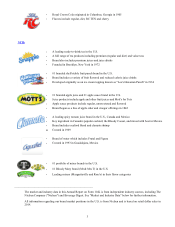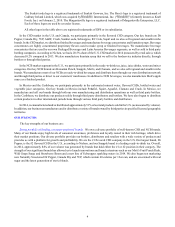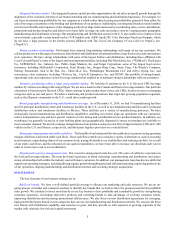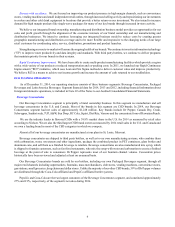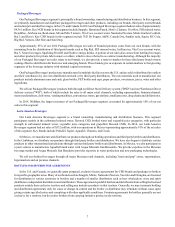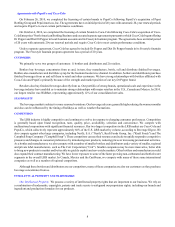Snapple 2014 Annual Report Download - page 16
Download and view the complete annual report
Please find page 16 of the 2014 Snapple annual report below. You can navigate through the pages in the report by either clicking on the pages listed below, or by using the keyword search tool below to find specific information within the annual report.
13
If we are unable to compete effectively, our sales could decline. As a result, we would potentially reduce our prices or increase
our spending on marketing, advertising and product innovation. Any of these could negatively affect our business and financial
performance.
We depend on a small number of large retailers for a significant portion of our sales.
Food and beverage retailers in the U.S. have been consolidating, resulting in large, sophisticated retailers with increased
buying power. They are in a better position to resist our price increases and demand lower prices. They also have leverage to
require us to provide larger, more tailored promotional and product delivery programs. If we and our bottlers and distributors do
not successfully provide appropriate marketing, product, packaging, pricing and service to these retailers, our product availability,
sales and margins could suffer. Certain retailers make up a significant percentage of our products' retail volume, including volume
sold by our bottlers and distributors. Some retailers also offer their own private label products that compete with some of our
brands. The loss of sales of any of our products by a major retailer could have a material adverse effect on our business and financial
performance.
We depend on third party bottling and distribution companies for a portion of our business.
Net sales from our Beverage Concentrates segment represent sales of beverage concentrates to third party bottling companies
that we do not own. The Beverage Concentrates segment's operations generate a significant portion of our overall segment operating
profit ("SOP"). Some of these bottlers, such as PepsiCo and Coca-Cola, are also our competitors. The majority of these bottlers'
business comes from selling either their own products or our competitors' products. In addition, some of the products we manufacture
are distributed by third parties. As independent companies, these bottlers and distributors make their own business decisions. They
may have the right to determine whether, and to what extent, they produce and distribute our products, our competitors' products
and their own products. They may devote more resources to other products or take other actions detrimental to our brands. In most
cases, they are able to terminate their bottling and distribution arrangements with us without cause. We may need to increase
support for our brands in their territories and may not be able to pass on price increases to them. Their financial condition could
also be adversely affected by conditions beyond our control, and our business could suffer as a result. Deteriorating economic
conditions could negatively impact the financial viability of third party bottlers. Any of these factors could negatively affect our
business and financial performance.
Determinations in the future that a significant impairment of the value of our goodwill and other indefinite-lived intangible
assets has occurred could have a material adverse effect on our results of operations.
As of December 31, 2014, we had $8,273 million of total assets, of which approximately $5,674 million were goodwill and
other intangible assets. Intangible assets include both definite and indefinite-lived intangible assets in connection with brands,
distribution rights and customer relationships. We conduct impairment tests on goodwill and all indefinite-lived intangible assets
annually, as of October 1, or more frequently if circumstances indicate that the carrying amount of an asset may not be recoverable.
If the carrying amount of an intangible asset exceeds its fair value, an impairment loss is recognized in an amount equal to that
excess. There was no impairment required based upon our annual impairment analysis performed as of October 1, 2014. For
additional information about these intangible assets, see "Critical Accounting Estimates — Goodwill and Other Indefinite-Lived
Intangible Assets" and "Management's Discussion and Analysis of Financial Condition and Results of Operations," in Item 7 and
our Audited Consolidated Financial Statements included in Item 8, "Financial Statements and Supplementary Data," in this Annual
Report on Form 10-K.
The impairment tests require us to make an estimate of the fair value of our reporting units and other intangible assets. An
impairment could be recorded as a result of changes in assumptions, estimates or circumstances, some of which are beyond our
control. Factors which could result in an impairment include, but are not limited to: (i) reduced demand for our products; (ii) higher
commodity prices; (iii) lower prices for our products or increased marketing as a result of increased competition; (iv) significant
disruptions to our operations as a result of both internal and external events; and (v) changes in our discount rates. Since a number
of factors may influence determinations of fair value of intangible assets, we are unable to predict whether impairments of goodwill
or other indefinite-lived intangibles will occur in the future. Any such impairment would result in us recognizing a non-cash charge
in our Consolidated Statements of Income, which could increase our effective tax rate and adversely affect our results of operations.


